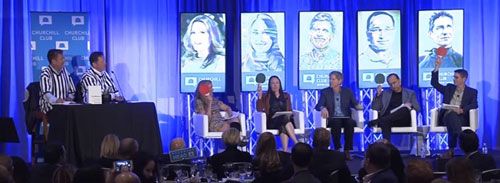 By Jeff Richards
By Jeff Richards
Managing Partner
Each year the Churchill Club, a not-for-profit public benefit organization, holds a “Top 10 Tech Trends” meeting. A panel of five venture capital partners each present two predictions regarding the top tech trends that will be affecting the market four or five years from now. Each VC presents their first prediction and the other VCs vote on it. Then the moderator turns it over to the audience members, who use an app to register their votes. After each panel member has presented their first idea, the moderator goes down the line and repeats the process for their second idea.
I’ve been attending this event for 13 years now. I’ve found that the meeting is both thought-provoking and entertaining, and a great way to get executives thinking out of the box beyond their annual planning horizon. Plus, it usually gives me lots of interesting things to talk about at client meetings, cocktail parties and networking events!
This year was the 21st annual edition of this event, and there were probably 600 to 700 people in attendance. CIO Professional Services bought a table. Everyone in our group of nine really enjoyed the event, which spurred some very stimulating conversation.
About the voting
At the Top 10 Tech Trends event a “no” vote means that the trend is either (a) obvious or already being widely implemented or (b) not likely to come to market within the next four to five years. You vote “yes” when you think something is new, unusual and will bear fruit within the next four to five years.
While you can download the entire Top 10 list, I thought I’d share my thoughts on a few of them…
The big winner: Putting silicon back into Silicon Valley
This year the VC and audience voting produced only one clear “winner,” and this was it. The votes came up 79% in favor of Navin Chaddha of Mayfield’s prediction that the renaissance of silicon will create industry giants. Navin’s argument was that with the end of Moore’s Law, new semiconductors are required for our cloud-native, data-dominated, AI-powered IoT world. I agree with this assessment, and one of our guests, the CIO of semi-conductor firm Advanced Micro Devices, was certainly quite pleased with this prediction!
Ho hum: Distributed workforces will become the norm
While this prediction from Rebecca Lynn of Canvas Ventures received a 53% “yes” vote, the general feeling was “ho hum – distributed workforces are already the norm.” Rebecca predicted that collaboration software such as Notion and Zoom will facilitate the ability for most dev teams to have a global presence. As far as I (and most of the audience members) was concerned, this is nothing new, cool or unusual. Many if not most of us here in the Silicon Valley already have distributed workforces, even if we’re not working in software development. CIO Professionals, for example, has team members in the West Coast, Denver, Chicago, Boston and South Florida.
Yeah, right: Using digital technology to treat mental health
Jeff Crowe of Norwest Venture Partners predicted that digital modalities such as machine learning or texting with your psychotherapist will offer everyone access to effective mental health treatment. This idea received a 53% “yes” vote. The general response among the 47% of people who voted no: “Yeah, right. There’s no way this is going to provide effective treatment for complex mental health issues.”
Great ideas that face some hurdles: Functional medicine and flexible fertility management
Rebecca Lynn predicted the rise of one-stop shop companies that use diagnostics and diet to create actionable results in the functional medicine sphere. Lauren Kolodny of Aspect Ventures predicted that flexible fertility services will become commonplace in response to the seismic cultural shift that’s taking place right now around how and when people have families.
While the VCs and audience members that these were very plausible ideas, neither came up as a big winner (flexible fertility management got a 57% positive vote, and functional medicine got 54%). Why didn’t all those people who liked the ideas vote yes? Because these ideas didn’t pass the “likely to come to fruition” test. Many felt that the financial model for these concepts would be prohibitive, as the health insurance companies would likely be very resistant to adopting these ideas. Without insurance coverage, only those who can afford to pay for these advances out of pocket will utilize them.
The big loser: Using bio-electronic wearables to address screen addiction
Brian Ascher of Venrock predicted that consumers will recognize their unhealthy addiction to the dopamine hits of social media, and be willing to do something about it. His solution: immersive, non-invasive VR/AI/bioelectronics wearables that induce states of relaxation, mindfulness and peak performance.
While we all agreed that addiction to the small screen is a problem for many of us, no one thought that the use of another type of screen was going to fix this. This got a big 70% “no” vote.
Conclusion
Having been to this event so many times, I was struck by how many of this year’s tech trends predictions got voted down. Only time will tell who was right—the audience or the VCs!


